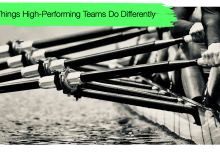
How to win the war for talent
By Michelle Elstein, Co-Founder, Courageous Co.
Changing of the tide
How quickly the tide has changed from the gratitude people felt for job security during the pandemic. According to Microsoft’s 2021 Work Trend Index, 41 per cent of people are likely to consider leaving their jobs within the next 6-12 months. That’s a big number.
Think about the implications for a minute. As a business leader, almost half of your team may, right now, be thinking about leaving you. The war for talent is real. Whatever recruitment and retention strategies you have used in the past need to be reviewed and adapted, and the sooner the better.
What is it that people want now?
Different factors will contribute to whether an employee decides to stay, leave or join you including any, or all, of the following:
- People finally feel confident searching for a new job
- People have reset their priorities
- Burnout is high, with the average Microsoft Teams user sending 42 per cent more chats after hours
- Career growth is becoming a top priority now that we are through ‘survival’ mode
- Better financial opportunities are presenting themselves with job moves given the war for talent
- People have realised they don’t actually like their jobs!
But, you know all this already and while there will always be things as a leader that you can’t control, there is plenty that you can. The question to consider is, how can you make changes that will have the impact that you need as quickly as possible?
Do things differently, practically and quickly.
Addressing every individual need can’t be the way to recruit and retain a whole team. A comprehensive approach to your overall ‘People Strategy’ will work best to sustain team performance and retain talent. In an ideal world, you will choose to recruit people for their potential and not enter into burdensome financial negotiations and competition. Equally, you will create a sense of belonging with open and psychologically safe environments so people can be the best of themselves, rather than look elsewhere.
We do things differently with our Courageous clients. We experiment with new approaches and iterate. This article shares two strategies which we are working on proactively with clients right now to retain, develop and build high performing teams in this dynamic market. There are very few quick wins in this world right now, but by doing things differently before others, you will gain in the long term. We’re seeing it happen.
STRATEGY 1: Focus on roles and not jobs
A job is defined as ‘a piece of work, especially for a specific task done as part of the routine of a person’s occupation or for an agreed price’. Synonyms include ‘task’ or ‘position’.
A role is defined as ‘a function assumed by a person for a specific purpose’. Synonyms include, ‘capacity’ and ‘responsibility’.
Which is more appealing – a job or a role? Which offers greater opportunity – a job or a role?
For too many years, we have focused on ‘jobs’ that people need to fulfil. It’s time to take the mindset that people are potential and not resources. They want to be developed not utilised.
Building a team based on roles that can stretch and flex, rather than a team of job-doers, means moving away from traditional job descriptions. The way to attract, motivate and retain your people for the long term is to adopt our Role Scoping Model below.
COURAGEOUS ROLE SCOPING MODEL

© Courageous Growth Co. Ltd
While a traditional approach to job descriptions will be more prescriptive, the Role Scoping Model allows you to create scope and stretch for each of your team members in a way that is modern and aligned to what candidates value today. Working with everyone, all aligned at the centre to your Team Purpose (see below), you can challenge them to own their individual role and development plan:
– My contribution to our organisation – Give people opportunity to stretch their learning and development by working on special projects or with different stakeholders. This will build better corporate understanding, advocacy for your team and a more loyal team member.
– My contribution to our team – Involve people in setting and understanding the big picture to team priorities and culture. Challenge them to evaluate how efficient, purposeful, and productive they are. It will improve motivation and collaboration.
– My contribution to my own growth – This is usually an afterthought rather than an equal element to individual roles. Giving people agency to manage their wellbeing, professional and personal growth in such a way as it adds value to the team and the organisation is very different than a tickbox approach.
Making the shift from your status of jobs to roles within your structure doesn’t need to be difficult and you don’t need to get it 100% right on the first attempt. Make it an iterative process and communicate with transparency and your team will help you get it right. From there, let it be a living and breathing approach to your performance and goal setting process.
STRATEGY 2: Be a purposeful Chief Repetition Officer
At the centre of the Role Scoping Model is ‘Team Purpose’. Whenever we ask a client what the purpose of their team is and how they all collectively add value to the business, we get a slightly convoluted answer. That said, if we ask repeatedly, we do get consistency of response.
However, when we ask team members, they do not have that same clarity or consistency. In a market where people need more certainty and a strong sense of belonging, getting clear on your Legal Team Purpose is business critical not a luxury.
We recommend that GCs involve their senior leaders in the initial drafting of a Purpose statement, and then socialise it with the team at a virtual or physical offsite/meeting. Working with the team, you can consider how to apply it to all aspects of team life and work. This kind of engagement process builds clarity, morale, belonging and more meaning to people’s roles.
You and your lead team then need to assume the role of Chief Repetition Officers – you repeat your Purpose over and over and over again. Check that all priorities point back to the Purpose. Align roles and objectives to the Purpose. Articulate your value to the business based on the Purpose. Set meeting agendas based on the discussion points aligning to your Purpose. You get the idea…
When you reach the point of becoming bored of the sound of your own voice, it will just about be getting through. To litmus test whether this is working and making a difference, consider the following questions:
- If your newest recruit, your most junior team members or your stakeholders are asked to articulate the Purpose of your team, will they all give the same answers?
- Where and how is your Purpose shared with the team?
- How can you make your Purpose clearer and more impactful?
- Are all your priorities aligned with your overall Purpose?
- What is the cost of not working in a way that is aligned to a clear and common Purpose?
It’s very easy to say you’re too busy to sit down with your team and work on your Purpose, but you don’t get in the car without knowing where you’re going. It will save time and money in the long run.
Making it happen
The practical strategies shared here can help you make seismic shifts in morale, teambuilding and retention. It will take a conscious decision to move to different ways of working and communication. It will need investment, mostly of your time as well as your patience and empathy. The question to ask yourself is, as a leader can I afford not to do this?




